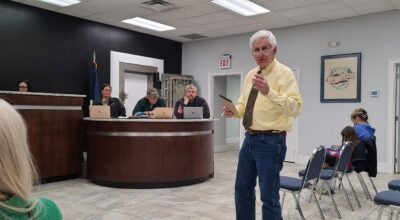Passover Seder held at Centre
Published 8:13 am Friday, April 14, 2017
More than 70 students, faculty and community members gathered at the Combs Center Warehouse for a Passover Seder meal Wednesday night, which began on April 10.
“In a predominantly Christian part of the country, it’s important for Christians to see that there are Jews, that Judaism is a thriving tradition, and to be able to participate in it,” said Shayna Sheinfeld, visiting assistant professor of Religion at Centre College.
The Seder was open to the public and led by Shana Sippy, visiting instructor in Religion and Women’s and Gender Studies at Carleton College, and by Sheinfeld.
There are about 15 students who identify as Jewish on the campus, Sheinfeld said, a number that seems to hold steady each year.
Sippy said the Seder is normally done in the home, not in large groups.
“This is something that happens in the home, it’s not usually done in a congregation. It’s done around a table — which is a centerpiece of Jewish life, actually,” she said. “There’s living Judaism and tradition is always about continuity and innovation at the same time. For me, it’s about educating people that that tradition is not stagnant.”
“It’s about relevance. You ask the same questions every year and it’s thinking about what they mean in the past and what they mean for us today. It’s the same thing, same foods, and yet, it’s different.”
The Passover Haggadah, which gives direction to the Seder, uses the story of the Jews as slaves in Egypt and the process of God leading them out of slavery to wander in the desert before bringing them to the promised land, as a way to reflect on the past and remember what God has done. There are traditional aspects to it, but over the years, things have been added to maintain relevance.
In other words, the story doesn’t change — but it’s made relevant by reflection on the past and on the current situation.
“The story is about being enslaved, being oppressed and the process of freedom, and thinking about it. Part of the story is reflecting back on the event itself, and then you just kind of bring that to another level. What does it mean to be oppressed now, even if we’re not,” Sheinfeld said.
Seder Plates include:
• maror and chazeret, bitter herbs — horseradish was served, but there are variations;
• charoset, a sweet mixture to represent the mortar used by Hebrew slaves to build while in Egypt;
• karpas, a vegetable to be dipped in salt water — parsley was used;
•zeroa, or a special meat, to represent the sacrifices, and to represent the passing over of the angel of death, the last plague in Egypt — lamb was used, but for vegetarians, beets can be substituted; and
• Beitzah, a roasted hard-boiled egg, to represent the festival sacrifice, and was also used as a symbol of new life.
Over the years, things have been added. Sippy included:
• an orange, to represent the gay and lesbian Jewish community, an addition made by Susannah Heschel in the 1980s; and
• a banana, to represent refugees, in memory of Aylan, Galip and Rihan Kurdi, who drowned trying to escape Syria with their father and husband Abdullah, who survived. The young brothers, 3 and 5, loved bananas and would often be treated to the luxury by their father, who would bring them one to share. The addition was made by Rabbi Dan Moskovitz this year.
It’s more than just a commandment about how to eat or what to eat or how to celebrate, Sippy said, but also a commandment of how to live — how to treat strangers, slaves, the hungry and the oppressed, which is why poems and readings were included that talked about issues facing the world, such as mass incarceration, the refugee crisis, and other issues.
Many of the members in attendance were not of the Jewish faith, such as Emily Cranford, visiting assistant professor of French and Humanities at the college. She attended in support of Sheinfeld, her friend and colleague, and her Jewish students. Cranford said she had also grown up with many Jewish friends, so she was familiar with the Seder.
“It’s really nice. I like the added elements. It’s nice to see a lot of students who are also curious and want to participate,” Cranfield said.
Students like Valentine Banner, who came in support of a friend who is an observant Jew. Banner is also an international relations major, taking classes like religion and politics.
“We’re talking about how religion plays into politics, as well, the whole refugee crisis and it being such a focus, especially in this Seder, it’s very interesting. For me, it’s just taking it all in, to reflect on it,” Banner said. “It’s been a great experience.”
Another student, James Easton, is currently taking a religion class at the college and said he enjoyed the Seder.
“There’s a big difference in reading about religion and experiencing it, you know? It’s … intellectually stimulating,” he said.
During the Seder, attendees were served lamb brisket, matzah-ball soup, grilled vegetables, gefilte fish on bread and charoset. The meal also included grape juice and a dessert of coconut macaroons.
Typically, a Seder is done over the course of several hours leading up to midnight — Wednesday’s Seder at the college was an “abridged version,” Sippy explained.
One of the important aspects to remember, she said, is that the Passover Haggadah is done in first-person.
“This isn’t somebody else’s story. That’s a crucial piece of it,” Sippy said.
As she interacted with those in attendance during the Seder, which involved Sippy reading in some cases, others reading in some cases and in some parts everyone reading, Sippy said it was important because, “if you say ‘you,’ and don’t include yourself, then you don’t see yourself as part of the story or part of the problem, either.”
Follow Kendra Peek on Twitter, @knpeek.






